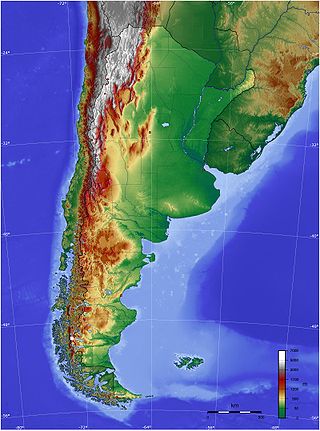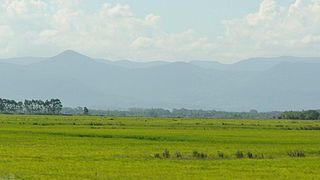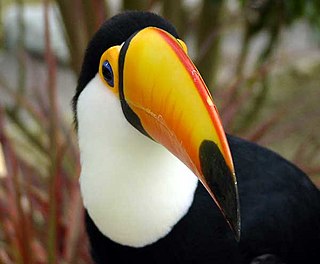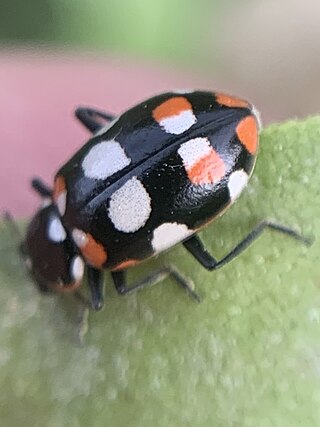
The environment of Argentina is highly biodiverse.

The environment of Argentina is highly biodiverse.
Subtropical plants dominate the Gran Chaco in the north, with the Dalbergia genus of trees well represented by Brazilian rosewood and the quebracho tree; also predominant are the wacho white and black algarrobo trees ( Prosopis alba and Prosopis nigra ). Savannah-like areas exist in the drier regions nearer the Andes. Aquatic plants thrive in the wetlands of Argentina. In central Argentina the humid pampas are a true tallgrass prairie ecosystem. [1]
In Argentina forest cover is around 10% of the total land area, equivalent to 28,573,000 hectares (ha) of forest in 2020, down from 35,204,000 ha in 1990. In 2020, naturally regenerating forest covered 27,137,000 ha and planted forest covered 1,436,000 ha. Of the naturally regenerating forest 0% was reported to be primary forest (consisting of native tree species with no clearly visible indications of human activity) and around 7% of the forest area was found within protected areas. For the year 2015, 0% of the forest area was reported to be under public ownership, 4% private ownership and 96% with ownership listed as other or unknown. [2] [3]
The original pampa had virtually no trees; some imported species like the American sycamore or eucalyptus are present along roads or in towns and country estates (estancias). The only tree-like plant native to the pampa is the evergreen ombú. The surface soils of the pampa are a deep black color, primarily mollisols, known commonly as humus. This makes the region one of the most agriculturally productive on Earth; however, this is also responsible for decimating much of the original ecosystem, to make way for commercial agriculture. The western pampas receive less rainfall, this dry pampa is a plain of short grasses or steppe. [1]
Most of Patagonia lies within the rain shadow of the Andes, so the flora, shrubby bushes and plants, is suited to dry conditions. The soil is hard and rocky, making large-scale farming impossible except along river valleys. Coniferous forests in far western Patagonia and on the island of Tierra del Fuego, include alerce, ciprés de la cordillera, ciprés de las guaitecas, huililahuán, lleuque, mañío hembra and pehuén, while broadleaf trees include several species of Nothofagus such as coihue, lenga and ñire. Other introduced trees present in forestry plantations include spruce, cypress and pine. Common plants are the copihue and colihue. [4]
In Cuyo, semiarid thorny bushes and other xerophile plants abound. Along the many rivers grasses and trees grow in significant numbers. The area presents optimal conditions for the large scale growth of grape vines. In northwest Argentina there are many species of cactus. No vegetation grows in the highest elevations (above 4,000 m (13,000 ft)) because of the extreme altitude.
Many species live in the subtropical north. Prominent animals include big cats like the jaguar and puma; primates (howler monkey); large reptiles (crocodiles), the Argentine black and white tegu and a species of caiman. Other animals include the tapir, peccary, capybara, bush dog, and various species of turtle and tortoise. There are a wide variety of birds, notably hummingbirds, flamingos, toucans, and swallows.
The central grasslands are populated by the giant anteater, armadillo, pampas cat, maned wolf, mara, cavias, and the rhea (ñandú), a large flightless bird. Hawks, falcons, herons, and tinamous (perdiz, Argentine "false partridges") inhabit the region. There are also pampas deer and pampas foxes. Some of these species extend into Patagonia.
The western mountains are home to animals including the llama, guanaco and vicuña which are among the most recognizable species of South America. Also in this region are the fox, viscacha, Andean mountain cat, kodkod, and the largest flying bird in the New World, the Andean condor.
Southern Argentina is home to the cougar, huemul, pudú (the world's smallest deer), and introduced, non-native wild boar. [4] The coast of Patagonia is rich in animal life: elephant seals, fur seals, sea lions and species of penguin. The far south is populated by cormorants.
The territorial waters of Argentina have abundant ocean life. There are mammals such as dolphins, orcas, and whales, like the southern right whale, which is a major tourist draw. Sea fish include sardines, Argentine hakes, dolphinfish, salmon, and sharks; also present are squid and king crab (centolla) in Tierra del Fuego. Rivers and streams in Argentina have many species of trout and the South American golden dorado. Well known snake species inhabiting Argentina include boa constrictors and a very venomous pit viper named the yarará. The hornero was elected the national bird after a survey in 1928. [5]
Insects, like Eriopis connexa are found throughout the country. [6]
| | This section needs expansion. You can help by adding to it. (November 2020) |
The largest fresh-water oil spill was caused by the Estrella Pampeana , a Shell Petroleum tanker in the Río de la Plata, off Magdalena, on January 15, 1999, polluting the environment, drinking water, and local wildlife. [7]
Argentina had a 2018 Forest Landscape Integrity Index mean score of 7.21/10, ranking it 47th globally out of 172 countries. [8]

The geography of Argentina is heavily diverse, consisting of the Andes Mountains, pampas, and various rivers and lakes. Bordered by the Andes in the west and the South Atlantic Ocean to the east, its neighbouring countries are Chile to the west, Bolivia and Paraguay to the north, and Brazil and Uruguay to the northeast.

A grassland is an area where the vegetation is dominated by grasses (Poaceae). However, sedge (Cyperaceae) and rush (Juncaceae) can also be found along with variable proportions of legumes, such as clover, and other herbs. Grasslands occur naturally on all continents except Antarctica and are found in most ecoregions of the Earth. Furthermore, grasslands are one of the largest biomes on Earth and dominate the landscape worldwide. There are different types of grasslands: natural grasslands, semi-natural grasslands, and agricultural grasslands. They cover 31–69% of the Earth's land area.

A savanna or savannah is a mixed woodland-grassland biome and ecosystem characterised by the trees being sufficiently widely spaced so that the canopy does not close. The open canopy allows sufficient light to reach the ground to support an unbroken herbaceous layer consisting primarily of grasses. Four savanna forms exist; savanna woodland where trees and shrubs form a light canopy, tree savanna with scattered trees and shrubs, shrub savanna with distributed shrubs, and grass savanna where trees and shrubs are mostly nonexistent.

Cortaderia is a genus of plants in the Poaceae or grass family of plants.

The Pampas, also known as the Pampas Plain, are fertile South American low grasslands that cover more than 1,200,000 square kilometres (460,000 sq mi) and include the Argentine provinces of Buenos Aires, La Pampa, Santa Fe, Entre Ríos, and Córdoba; all of Uruguay; and Brazil's southernmost state, Rio Grande do Sul. The vast plains are a natural region, interrupted only by the low Ventana and Tandil hills, near Bahía Blanca and Tandil (Argentina), with a height of 1,300 m (4,265 ft) and 500 m (1,640 ft), respectively.

The Atlantic Forest is a South American forest that extends along the Atlantic coast of Brazil from Rio Grande do Norte state in the northeast to Rio Grande do Sul state in the south and inland as far as Paraguay and the Misiones Province of Argentina, where the region is known as Selva Misionera.

The Sierras de Córdoba is a mountain range in central Argentina, located between the Pampas to the east and south and the Chaco to the north and east. Most of the range is located in Córdoba Province, except for the southwestern margin which is in San Luis Province.

The Semi-arid Pampas, also known as the Dry Pampas, is a temperate grassland ecoregion of south central Argentina.

The Pampas deer is a species of deer that live in the grasslands of South America at low elevations. They are known as veado-campeiro in Portuguese and as venado or gama in Spanish. It is the only species in the genus Ozotoceros.

The Humid Pampas is an extensive ecoregion of flat, fertile grassland of loessic origin in Argentina. It has a precipitation average of 900 mm per year, in contrast with the Dry Pampas to the west, which average less than 700 mm.

The wildlife of Brazil comprises all naturally occurring animals, plants, and fungi in the South American country. Home to 60% of the Amazon Rainforest, which accounts for approximately one-tenth of all species in the world, Brazil is considered to have the greatest biodiversity of any country on the planet. It has the most known species of plants (60,000), freshwater fish (3,000), amphibians (1,188), snakes (430), insects (90,000) and mammals (775) It also ranks third on the list of countries with the most bird species (1,971) and the third with the most reptile species (848). The number of fungal species is unknown. Approximately two-thirds of all species worldwide are found in tropical areas, often coinciding with developing countries such as Brazil. Brazil is second only to Indonesia as the country with the most endemic species.

The Reserva Provincial La Payunia also known as Payún or Payén is a natural reserve located in the Malargüe Department in the southern part of Mendoza Province, Argentina, about 160 km away from Malargüe city. It was declared as nature preserve in 1988 and has an area of 4,500 km2. La Payunia is home to the many volcanic cones, being noteworthy the Payún Matrú volcano.

The wildlife of Angola is composed of its flora and fauna.

Prosopis tamarugo, commonly known as the tamarugo, is a species of flowering tree in the pea family, Fabaceae, subfamilia Mimosoideae. It is only found in northern Chile, particularly in the Pampa del Tamarugal, some 70 km (43 mi) east of the city of Iquique. This bushy tree apparently grows without the benefit of rainfall, and it is thought to obtain some water from dew. Studies indicate it is a Phreatophyte; having deep roots that tap into ground water supplies. It also participates in hydraulic redistribution moving water from deeper levels to the upper and also reversing the process in times of severe drought.

The rufous-tailed hawk is a species of bird of prey in the family Accipitridae.

The scimitar-billed woodcreeper is a species of bird in the subfamily Dendrocolaptinae of the ovenbird family Furnariidae. It is found in Argentina, Bolivia, Brazil, Paraguay, and Uruguay.

Peru has some of the greatest biodiversity in the world. It belongs to the select group of mega diverse countries because of the presence of the Andes, Amazon rainforest, and the Pacific Ocean. It has the fourth-most tropical forests of any country and the ninth-most forest area. The country is ranked among the five countries with the greatest biodiversity in the world according to various studies.

Eriopis connexa is a species of ladybird beetle that is native to South America. Both males and females mate multiple times with different individuals of the opposite sex, like most members of the family Coccinellidae. This promiscuous behavior leads to unique reproductive adaptations, such as sperm mixing. Females lay unfertilized eggs which their offspring consume upon hatching, thereby boosting offspring nutrition and reducing sibling cannibalism,. This predatory beetle species feeds primarily on aphids and is widespread throughout many agroecosystems, such as cotton, maize, sorghum, soybean, and wheat. Due to aphids being extremely damaging agricultural pests, E. connexa has been introduced to the United States for biological pest management. Recent studies on pyrethroid insecticide resistance in E. connexa have led to research by applied entomologists on the species' potential role in integrated pest management schemes in crop fields that rely on lambda-cyhalothrin (LCT), a common pyrethroid insecticide that is ineffective against aphid population control. The potential efficacy and success of the utilization of E. connexa in these programs is widely debated and is the focus of much recent research due to the lack of understanding regarding the effects of pyrethroid resistance on the behavior of this species.

The Espinal (NT0801) is an ecoregion of dry, thorny forest, savanna and steppe in Argentina. It has been extensively modified by large scale cattle ranching, but remnants of the original flora remain. It is threatened by the advance of the irrigation-based agricultural frontier.
The paleoethnobotany of the Mapuche focuses on archaeological evidence supporting plant use by past and present Mapuche populations collected from multiple sites in southern Chile and the Patagonia region of Argentina. Paleoethnobotany is the study of fossil and material remains from plants, mostly seeds and residues that can be analyzed from material remains. Data can be collected from archaeological sites with a particular interest in learning about the history of agriculture in a region or the use of plants for either subsistence or medicinal use. The Mapuche are an indigenous culture native to South America. The archaeological record has revealed that the Mapuche were present in modern-day south-central Chile and southwestern Argentina from at least 500-600 BC. It is also noteworthy, that while collectively the Mapuche use this endonym, there are often subsets of the culture that have more specific names based on geographic location as well as different ecological niches.